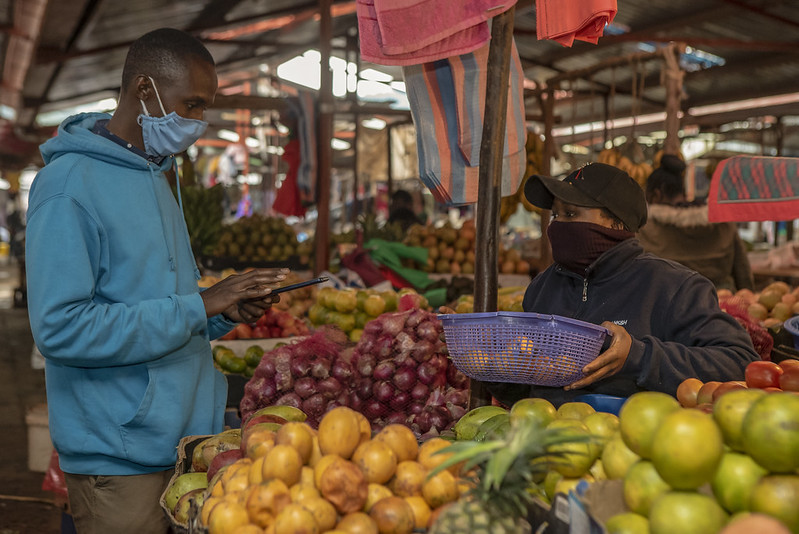COVID-19 Response: Africa’s Road to Recovery

While the COVID-19 pandemic has yet to come under control, many countries around the world have taken steps to economic recovery. African nations in particular, although prone to severe economic impacts, have shown significant progress in their COVID-19 response. According to the World Bank’s October 2020 Africa’s Pulse issue, GDP growth projections in all regions of Africa are positive for 2021 and 2022 following GDP growth decrease in 2020. This article highlights three countries that are demonstrating optimistic economic growth after COVID-19.
Rwanda
COVID-19 Response Measures: Rwanda has received recognition for its efforts to contain initial outbreaks. This is likely due to the country’s aggressive measures combining public health mandates and innovative utilization of technologies. What separates Rwanda’s response is its reliance on scientific guidance and a high-tech approach to health and social service policies. For example, treatment centers are using human-sized robots for temperature checks and supply deliveries. National enforcement also deployed drones to monitor and ensure compliance with lockdown measures.
Fiscal Policy: The December 2020 update on fiscal policy in Rwanda includes $314 million in economic stimulus, corporate tax exemptions and subsidies, cash transfers to citizens (unemployment benefits) and food assistance. Rwanda’s financial capacity proved beyond national resources but international support was able to expand it. UNDP Rwanda and the World Bank are currently working closely with the Rwanda Ministry of Finance to discern how much the COVID-19 response plan will need for operation.
Monetary Policy: The National Bank of Rwanda reduced the policy interest rate to 4.5%. It has further plans to establish liquidity and digital payment support measures. In Africa’s Pulse, the World Bank classifies Rwanda as the only country established in the Growth Taxonomy in sub-Saharan Africa. The taxonomy compares pre-pandemic performance to mid-pandemic growth. Expectations have determined that Rwanda will achieve the highest post-pandemic recovery with a GDP growth of 7%. With economic drivers like vaccine campaigns and investment and trade boosts, countries like Rwanda and Tanzania expect GDP increases. East Africa in general is expected to reach 5.1% GDP growth as opposed to the continental average at 3.2%.
Kenya
COVID-19 Response Measures: Kenya adopted many of the common direct response measures, such as a widespread lockdown. Additionally, the U.N. praised Kenya’s maintenance of well-equipped emergency treatment hospitals to best accommodate not only Kenyan patients but also U.N. personnel and partners. Kenya’s hospitals can also potentially play an important role in regional humanitarian development.
Fiscal Policy: Kenya announced a $534 million economic stimulus, a $377 million COVID-19 health expenditure, corporate tax exemptions and subsidies, cash transfers to citizens and food assistance. Like other African countries, Kenya is receiving financial assistance from major international entities such as the World Bank and the E.U. With 86 different donors, Kenya received Ksh 194,663,072,350 ($177,3769,915.25) for COVID-19 response plans.
Monetary Policy: The Central Bank of Kenya reduced the policy interest rate to 7% and planned liquidity support measures. Additionally, the government launched the National Hygiene Program (Kazi Mtaani) to reduce pandemic-induced unemployment. It offers employment with daily wages to the hardest-hit communities. Jobs include street cleaning, garbage collection and disinfection. Kenya’s trade activities also indicate promising economic recovery. According to the World Bank’s Africa’s Pulse, Kenyan exports have already recovered rapidly and have surpassed pre-pandemic highs.
Senegal
COVID-19 Response Measures: The World Bank highlighted Senegal as demonstrating a successful health response to COVID-19. Swift responses were key, particularly in regards to test capacity, quarantine facilities and ventilators. Preventative measures also included temperature checks and hand sanitizer distribution. By September 2020, 80% of confirmed cases had recovered.
Fiscal Policy: Senegal has an $801 million economic stimulus, a $130 million COVID-19 health expenditure, corporate tax exemptions and subsidies, cash transfers to citizens and food assistance. Some participating entities for Senegal’s financing include the African Development Bank Group (AfDB), the International Monetary Fund (IMF) and the World Bank. For instance, AfDB contributed €88 million to support Senegal’s measures to provide relief to vulnerable households, businesses and job security initiatives.
Monetary Policy: Senegal’s monetary policy is in collaboration with other West African countries, including Benin, Guinea-Bissau, Mali, Niger and Togo. These countries work with the Central Bank of West African States (BCEAO), which has made FCFA 4.750 billion ($8,383,750) available to banks and has reduced policy interest rates to 4%. In Africa’s Pulse Growth Taxonomy, Senegal is one of five countries in the top tercile of growth performers. It has a classification of “improved.” Improved GDP growth can indicate the first signs of economic recovery.
The Road to Recovery
As a result of early preventative policy measures, fiscal and monetary policies, international financing and trade initiatives, many African countries have paved a road to post-pandemic recovery. Rwanda, Kenya and Senegal are merely three of the African countries benefiting from smart policy measures and quick COVID-19 responses. In many cases, these countries are experiencing even higher levels of growth than they did before the pandemic. The steps that these countries and others took can serve as a model for how to navigate the economic hurdles of a global pandemic.
– Malala Raharisoa Lin
Photo: Flickr
